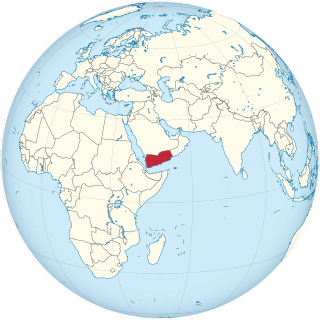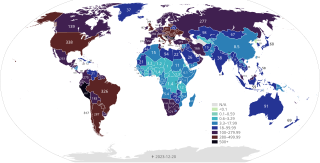| 2023 | |
|---|---|
| Disease | Cholera |
| Location | South Africa |
| Dates | 1 February 2023 – present |
On 1 February, 2023, a cholera outbreak began in South Africa. [1] [2] As of 26 August, 2023, 1,290 cases had been reported. [1]
| 2023 | |
|---|---|
| Disease | Cholera |
| Location | South Africa |
| Dates | 1 February 2023 – present |
On 1 February, 2023, a cholera outbreak began in South Africa. [1] [2] As of 26 August, 2023, 1,290 cases had been reported. [1]
The first cases of cholera were reported on 1 February 2023. [1]
In May, the Gauteng province health department declared an outbreak in Hammanskraal. [3] Fifteen deaths and 41 cases had been recorded as of May 22. [3] Residents blamed the local government for failing to provide adequate potable water. [3] [4]
By July 10, nearly 50 deaths had been recorded, [5] most of which occurred in Hammanskraal. [5]
On 16 January 2024, the health ministry confirmed two cases through laboratory tests in Limpopo province. [6]

The seventh cholera pandemic is the seventh major outbreak of cholera and occurred principally from the years 1961 to 1975, but the strain involved persists to the present. WHO and some other authorities believe this should be considered as an ongoing pandemic. As stated in its cholera factsheet dated 30 March 2022, the World Health Organization (WHO) continues to define this outbreak as a current pandemic, and with cholera having become endemic in many countries. In 2017, WHO announced a global strategy aiming to end this pandemic by 2030.

The 2008 Zimbabwean cholera outbreak was an epidemic of cholera affecting much of Zimbabwe from August 2008 until June 2009. The outbreak began in Chitungwiza in Harare Metropolitan Province in August 2008, then spread throughout the country so that by December 2008, cases were being reported in all 10 provinces. In December 2008, The Zimbabwean government declared the outbreak a national emergency and requested international aid. The outbreak peaked in January 2009 with 8,500 cases reported per week. Cholera cases from this outbreak were also reported in neighboring countries South Africa, Malawi, Botswana, Mozambique, and Zambia. With the help of international agencies, the outbreak was controlled, and by July 2009, after no cases had been reported for several weeks, the Zimbabwe Ministry of Health and Child Welfare declared the outbreak over. In total, 98,596 cases of cholera and 4,369 deaths were reported, making this the largest outbreak of cholera ever recorded in Zimbabwe. The large scale and severity of the outbreak has been attributed to poor sanitation, limited access to healthcare, and insufficient healthcare infrastructure throughout Zimbabwe.

The 2010s Haiti cholera outbreak was the first modern large-scale outbreak of cholera—a disease once considered beaten back largely due to the invention of modern sanitation. The disease was reintroduced to Haiti in October 2010, not long after the disastrous earthquake earlier that year, and since then cholera has spread across the country and become endemic, causing high levels of both morbidity and mortality. Nearly 800,000 Haitians have been infected by cholera, and more than 9,000 have died, according to the United Nations (UN). Cholera transmission in Haiti today is largely a function of eradication efforts including WASH, education, oral vaccination, and climate variability. Early efforts were made to cover up the source of the epidemic, but thanks largely to the investigations of journalist Jonathan M. Katz and epidemiologist Renaud Piarroux, it is widely believed to be the result of contamination by infected United Nations peacekeepers deployed from Nepal. In terms of total infections, the outbreak has since been surpassed by the war-fueled 2016–2021 Yemen cholera outbreak, although the Haiti outbreak is still one of the most deadly modern outbreaks. After a three-year hiatus, new cholera cases reappeared in October 2022.

Seven cholera pandemics have occurred in the past 200 years, with the first pandemic originating in India in 1817. The seventh cholera pandemic is officially a current pandemic and has been ongoing since 1961, according to a World Health Organization factsheet in March 2022. Additionally, there have been many documented major local cholera outbreaks, such as a 1991–1994 outbreak in South America and, more recently, the 2016–2021 Yemen cholera outbreak.
As of 24 September 2012, a cholera outbreak in Sierra Leone had caused the deaths of 392 people. It was the country's largest outbreak of cholera since first reported in 1970 and the deadliest since the 1994–1995 cholera outbreak. The outbreak has also affected Guinea, which shares a reservoir near the coast. This was the largest cholera outbreak in Africa in 2012.

H5N6 is a subtype of the species Influenza A virus. Infected birds shed the virus in their saliva, mucous, and feces. The virus was first detected in poultry in 2013, since then spreading among wild bird populations and poultry around the world. Humans can be infected through unprotected contact with infected birds or contaminated surfaces. The virus transmits by getting into a person's eyes, nose, mouth, and through inhalation. Human infections are rare. Since 2014, at least 87 cases have occurred in humans. 29 people have died. A spike in human cases was reported in 2021. There have been no confirmed cases of human-to-human transmission. Some infections have been identified where no direct contact with infected birds or contaminated surfaces has been known to had occurred. Only one infected woman has said that she never came into any contact with poultry.

An outbreak of cholera began in Yemen in October 2016. The outbreak peaked in 2017 with over 2,000 reported deaths in that year alone. In 2017 and 2019, war-torn Yemen accounted for 84% and 93% of all cholera cases in the world, with children constituting the majority of reported cases. As of November 2021, there have been more than 2.5 million cases reported, and more than 4,000 people have died in the Yemen cholera outbreak, which the United Nations deemed the worst humanitarian crisis in the world at that time. However, the outbreak has substantially decreased by 2021, with a successful vaccination program implemented and only 5,676 suspected cases with two deaths reported between January 1 and March 6 of 2021.

The 2017–2018 South African listeriosis outbreak was a widespread outbreak of Listeria monocytogenes food poisoning that resulted from contaminated processed meats produced by Enterprise Foods, a subsidiary of Tiger Brands, in Polokwane. There were 1,060 confirmed cases of listeriosis during the outbreak, and about 216 deaths. It is the world's worst ever listeriosis outbreak.

Mathume Joseph Phaahla is a South African politician who is currently serving as the Minister of Health since August 2021. He was formerly the Deputy Minister of Health from May 2014 to August 2021. He had been a deputy minister since May 2009, when he joined the National Assembly. He is also a member of the National Executive Committee of the African National Congress (ANC).

The 2018 Équateur province Ebola outbreak occurred in the north-west of the Democratic Republic of the Congo (DRC) from May to July 2018. It was contained entirely within Équateur province, and was the first time that vaccination with the rVSV-ZEBOV Ebola vaccine had been attempted in the early stages of an Ebola outbreak, with a total of 3,481 people vaccinated. It was the ninth recorded Ebola outbreak in the DRC.

This is a general overview and status of places affected by severe acute respiratory syndrome coronavirus 2 (SARS-CoV-2), the virus which causes coronavirus disease 2019 (COVID-19) and is responsible for the COVID-19 pandemic. The first human cases of COVID-19 were identified in Wuhan, the capital of the province of Hubei in China in December 2019.

The COVID-19 pandemic in mainland China is part of the worldwide pandemic of coronavirus disease 2019 (COVID-19) caused by severe acute respiratory syndrome coronavirus 2 (SARS-CoV-2). China was the first country to experience an outbreak of the disease, the first to impose drastic measures in response, and one of the first countries to bring the outbreak under control.

The first confirmed case relating to the COVID-19 pandemic in Yemen was announced on 10 April 2020 with an occurrence in Hadhramaut. Organizations called the news a "devastating blow" and a "nightmare scenario" given the country's already dire humanitarian situation.

The 2022–2023 Uganda Ebola outbreak was an outbreak of the Sudan ebolavirus, which causes Ebola, from 20 September 2022 until 10 January 2023 in the Western and Central Regions of Uganda. Over 160 people were infected, including 77 people who died. It was Uganda's fifth outbreak with Sudan ebolavirus. The Ugandan Ministry of Health declared the outbreak on 20 September 2022. As of 25 October 2022, there were confirmed cases in the Mubende, Kyegegwa, Kassanda, Kagadi, Bunyanga, Kampala and Wakiso districts. As of 24 October 2022, there were a total of 90 confirmed or probable cases and 44 deaths. On 12 October, the first recorded death in the capital of Kampala occurred; 12 days later on 24 October, there had been a total of 14 infections in the capital in the last two days. On 11 January 2023 after 42 days without new cases the outbreak was declared over.

In October 2022, an outbreak of cholera began in Lebanon. It is likely the result of a serious outbreak in neighboring Syria, which is itself traced back to contaminated water in the Euphrates.
Events in the year 2023 in South Africa.

The 2023–2024 Zambian cholera outbreak is currently one of the most severe health crises in the country's recent history, with its origins traced back to January 2023. The outbreak initially surfaced in Vubwi District in the Eastern Province and Mwansabombwe District in Luapula Province. By October 2023, the Zambia National Public Health Institute reported a cholera outbreak in the capital, Lusaka. Cholera cases have so far broken out in 15 districts in five out of the country’s 10 provinces, with Lusaka, the country’s capital recording the highest number of cases. Of particular concern is the rapid progression of the outbreak within Lusaka, where, within a week, the Ministry of Health reported a surge of 71.2% in cases and a staggering 175% increase in fatalities. Partners affiliated with DG ECHO actively collaborate with the Ministry of Health, providing crucial support in various capacities. Initiatives include community sensitization and risk communication, distribution and control of chlorine at critical water points, contact tracing, and the management of oral rehydration points within Lusaka. There is an urgent imperative to intensify community engagement and bolster the supply of safe water in affected areas, coupled with continuous monitoring of water quality.

A cholera outbreak started in Buhera District, Manicaland, Zimbabwe. The outbreak is thought to have started on 12 February 2023. As of now it has a geographic coverage of 45 out of 62 districts.
The 2022–2024 Southern Africa cholera outbreak is an outbreak that has spread across Southern Africa. It started in Machinga District in Malawi in March 2022. The cholera outbreak in Malawi linked to cases in South Africa, the strains belong to the seventh cholera pandemic. Rather than being a resurgence of a previously circulating strain in Africa, these cases likely resulted from the introduction of a new cholera agent from South Asia into Africa.